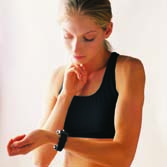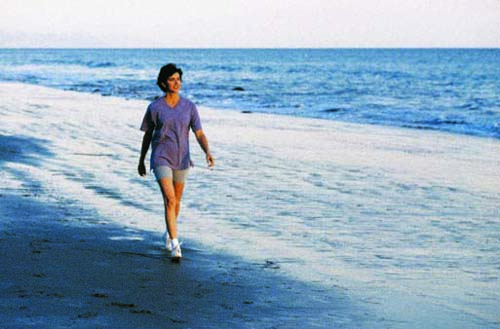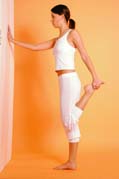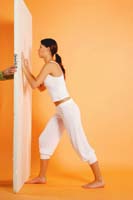Walking for your health
Walking is the most natural physical activity, appropriate for people of all ages. Also, studies have proven that briskly walking works out the body as much as running or high-impact aerobics, but without putting your joints at risk.
+ To get the most out of walking as a workout you should pay attention to your posture, clothing and rhythm.
∎ You should wear light clothing, preferably of cotton fiber (because it absorbs sweat). It's fundamental to wear comfortable shoes that support the feet without compressing them.
∎ To avoid injuries, like falls or twisting your ankle, you should first warm up. Walk slowly for five minutes before picking up rhythm.
∎ You should use a constant rhythm, until the last few meters of your walk, when you should use a slower rhythm.
∎ If, when on your walk, you have up hill or down hill, you should go and return on the same route to make up for your effort either way.
∎ Do 3 to 5 minutes of stretching before and after exercising. Stretch your arms, waist and legs to prevent any later pain or soreness from overstraining your muscles (see Pre-workout stretch box, on page 35).
IDEAL SHOE
You should be very careful in choosing your sports shoe. It should be flexible and comfortable with a cushioned and soft tongue, heel and toe. It should also support the foot. The heel should be slightly raised.

SPORTS WALKING PROGRAM
When you choose walking as your work out activity you need to plan how much and how fast you are going to walk, keeping in mind your physical shape and necessary training. We recommend starting with a moderate weekly routine, increasing the intensity as your body gains stamina and strength.
Head: looking straight ahead aligned with your spinal column.
Back: straight.
Arms: slightly bent at a straight angle in relation to the rest of your body. They should swing, relaxed, whilst keeping the same rhythm.
Feet: first step with your heels and then with the toes.

AEROBIC ACTIVITY
High intensity walking, as with all aerobic activity, causes an increase in your heart beat (amount of heartbeats per minute). The ideal frequency for this type of activity is 70% of: 220 minus the age of the person. For example, for a 40-year-old man it would be: 220 - 40 = 180 70% of 180 = 126 This means that for this man, his ideal heart rate during aerobic activity is 126.

Walking for beginners
For obese people, sedentary or elderly, it's recommended that you begin by walking 10 blocks (1,100 yards/1,000 meters) in 12 to 15 minutes, 3 times a week. Increase the distance by 2 blocks per day, until you end up walking a total distance of 30 to 50 blocks at a constant rhythm, controlling the time with your watch. Only when you begin walking 50 blocks (3 miles/5 km) at this rhythm can you go on to the next level.

Energetic walking
In this case, the speed is intensified. The objective is to walk, three times per week, 10 blocks (1,100 yards/1,000 meters) in 9 to 10 minutes, with the goal of trying to walk 30 to 50 blocks. (To work up speed its best to swing your arms alternately). At this pace one burns a good amount of energy.
Aerobic walking
This consists of walking at high speed. The method consists of walking 10 blocks (1,100 yards/1,000 meters) in 6 to 8 minutes. The results of this exercise are excellent for losing weight, increasing your cardiovascular strength and reducing stress. Aerobic walking burns as many calories (nearly 300) as running, at the same time helping you get into great shape.
Your steps should be fast and energetic, with your arms swinging and bent at a 90 degree angle to help you pick up your pace.
As with all aerobic exercises, you need a greater amount of oxygen, which increases your lungs’ capacity. This benefits your blood vessels, preventing the accumulation of fats and improving your heart function (see Aerobic activity box, on page 33).
PRE-WORKOUT STRETCH
Before and after you exercise, even with easy, light physical activity, including a simple walk, you should always take a few minutes to do stretching exercises to flex and relax your back.
BACK STRETCH
With your feet shoulder width apart, lift up an arm and place your other hand on your hip. Lean to the side where your arm is placed on the hip, to form an arch. Stay in this position for 10 seconds, breathing deeply. Repeat with the other arm.

STRETCHING YOUR LEGS
Place your right arm stretched out on a wall or tree. With your left hand wrap your hand around your left foot and bring it to your buttocks. You should feel your quadriceps muscles stretching. Stay in this position for 10 to 20 seconds. Repeat with your other leg.

STRETCHING YOUR ANKLES AND HEELS
Against a wall or tree, bring your right foot some 12 in/30 cm in front of the other. Lean forward, bending your knee forward and keeping your hands against the wall. Your leg should stay stretched out, so that you feel that your joints are elongated. Your feet should remain firmly on the ground during this exercise. Stay in this position for 15 to 30 seconds, release and repeat with your other leg.


Comment about this article, ask questions, or add new information about this topic: